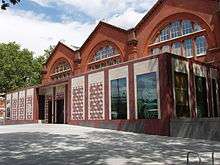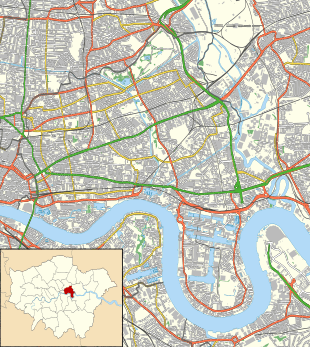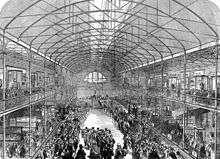V&A Museum of Childhood
The V&A Museum of Childhood is a branch of the Victoria and Albert Museum (the "V&A"), which is the United Kingdom's national museum of applied arts. It is in Bethnal Green and is located on the Green itself in the East End of London and specialises in objects by and for children.
 | |
 Location within London Borough of Tower Hamlets | |
| Established | 1872 |
|---|---|
| Location | Bethnal Green London, E2 United Kingdom |
| Coordinates | 51°31′44″N 0°03′18″W |
| Visitors | 418,271 (2018)[1] |
| Director | Rhian Harris |
| Public transit access | |
| Website | www |
Listed Building – Grade II* | |
| Designated | 27 September 1973 |
| Reference no. | 1357777 |
| Area | 1.5 acres (6,100 m2), 145 galleries |
History

The museum was founded in 1872[2] as the Bethnal Green Museum. The iron structure reused a prefabricated building from Albertopolis which was replaced with some early sections of the modern V&A complex. The exterior of the building was designed by James William Wild[3] in red brick in a Rundbogenstil (round-arched) style very similar to that in contemporary Germany.
The building was used to display a variety of collections at different times. In the 19th century, it contained food and animal products, and various pieces of art including the works which can now be seen at the Wallace Collection. It was remodelled as an art museum following World War I, with a children's section which subsequently grew in size. In 1974 the director of the V&A, Sir Roy Strong, defined it as a specialist museum of childhood.[3]
Of all the branches, the Bethnal Green Museum has the largest collection of childhood objects in the United Kingdom.
The mission of the museum is "To enable everyone, especially the young, to explore and enjoy the designed world, in particular objects made for and made by children." It has extensive collections of toys, childhood equipment and costumes, and stages a programme of temporary exhibitions.
The museum closed in October 2005 for the second phase of extensive renovations, costing £4.7 million. It reopened on 9 December 2006[4] with changes including a new front entrance, gallery, displays and café.
Inside the museum was a cast iron statue by John Bell, which has been based there since 1927.[3] It came originally from the Great Exhibition of 1851. "The Eagle slayer" shows a marksman shooting at an eagle which has slain the lamb that lies at his feet. This has now been moved to the entrance of the Coalbrookdale Museum as it was cast in the Coalbrookdale Foundry.
The museum is a Grade II* listed building.[5]
Transport connections
| Service | Station/Stop | Stop Letter | Lines/Routes served | Distance from V&A Museum of Childhood |
|---|---|---|---|---|
| London Buses |
Bethnal Green Station | Stop A | 106, 254, 309, 388, D3, D6 | |
| Stop B | 8, 309, D6 | |||
| Stop D | 8, 388, D3 | |||
| Old Ford Road | Stop G | 106, 254, 388, D6 | ||
| London Underground | Bethnal Green | |||
| London Overground |
Cambridge Heath | London Overground | 400 metres walk[6] |
See also
- Anthony Burton (former director)
References
Citations
- "ALVA - Association of Leading Visitor Attractions". www.alva.org.uk. Retrieved 18 August 2019.
- http://www.culture24.org.uk/history-and-heritage/art41998
- Weinreb et al. 2008, p. 65.
- http://www.culture24.org.uk/history-and-heritage/art41998
- Historic England. "Details from listed building database (1357777)". National Heritage List for England. Retrieved 8 August 2009.
- http://maps.google.co.uk/maps?f=d&source=s_d&saddr=United+Kingdom+(Cambridge+Heath+(London)+Rail+Station)&daddr=V%26A+Museum+of+Childhood&geocode=FcxQEgMdSiD__yGN544aq6qNOw%3BFfBEEgMdiSb__yHdyIVwB94bVw&hl=en&mra=pd&dirflg=w&sll=51.526238,-0.055764&sspn=0.056604,0.169086&ie=UTF8&z=17 Walking directions to V&A Museum of Childhood from Cambridge Heath (London) railway station
Sources
- Weinreb, Ben; Hibbert, Christopher; Keay, John; Keay, Julia (2008). The London Encyclopaedia (3rd ed.). Pan Macmillan. ISBN 978-1-405-04924-5.